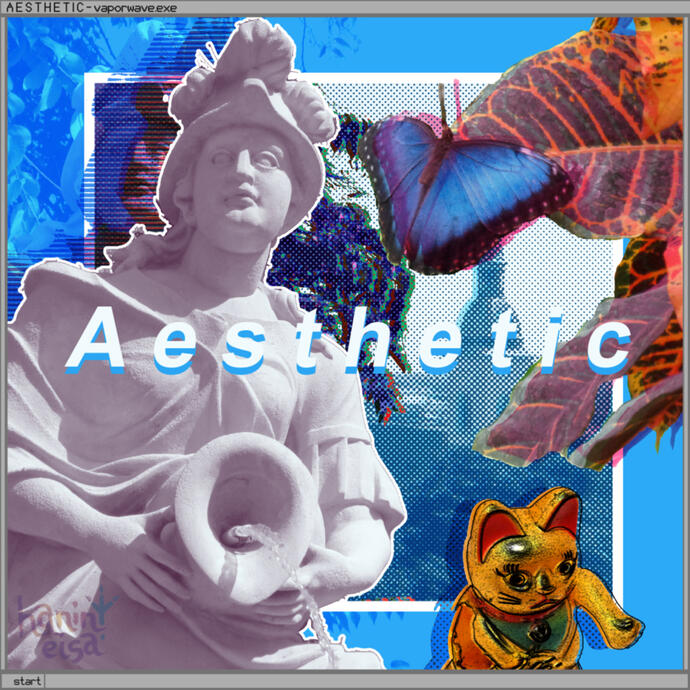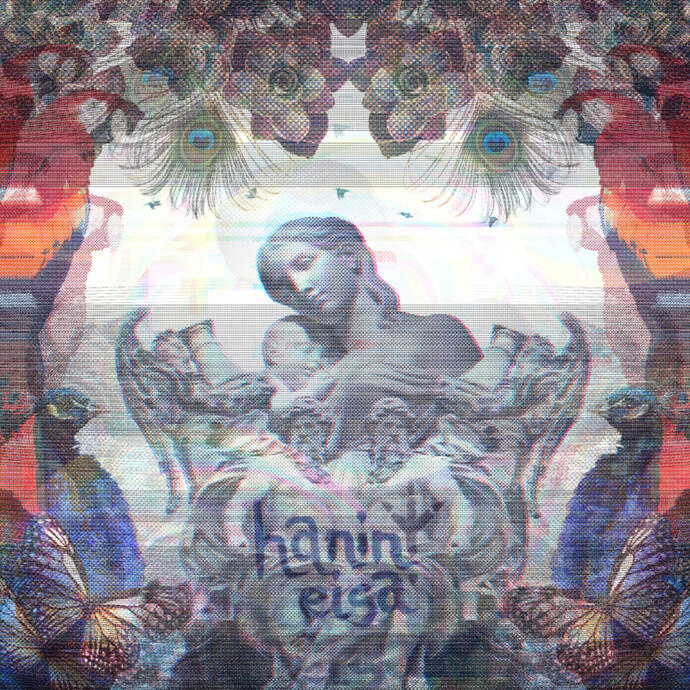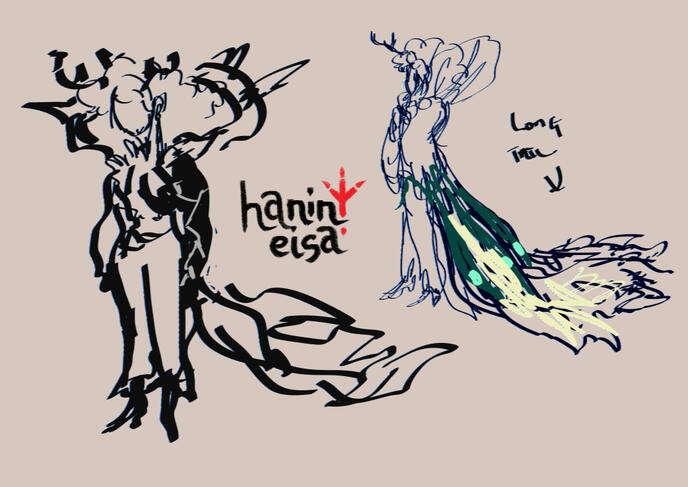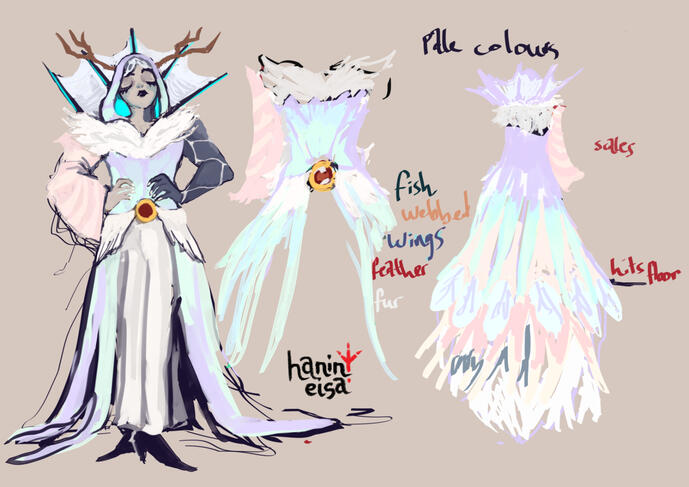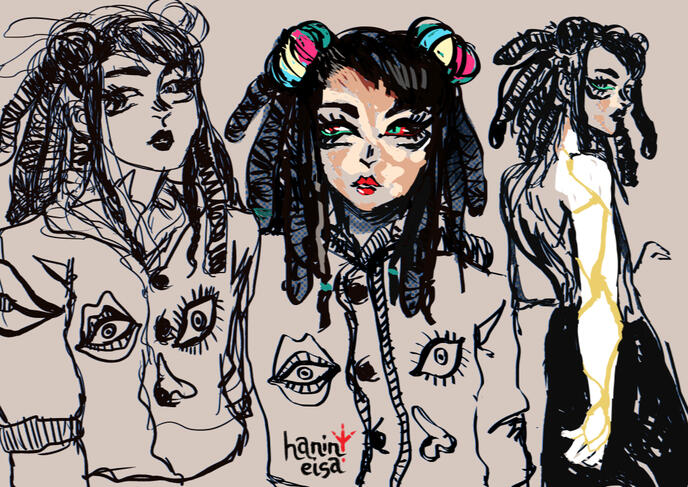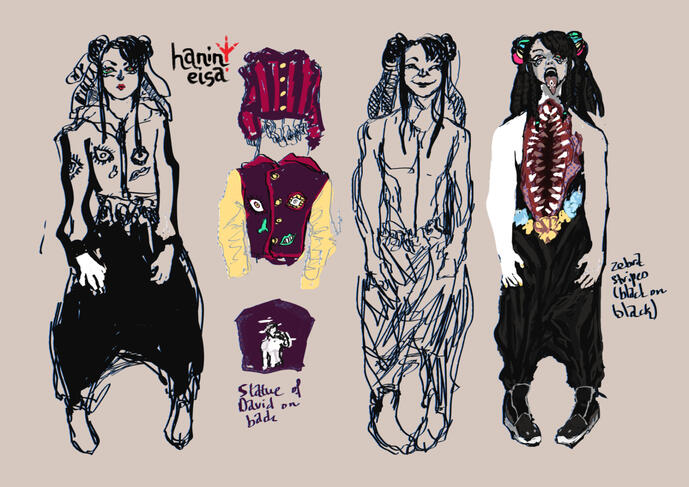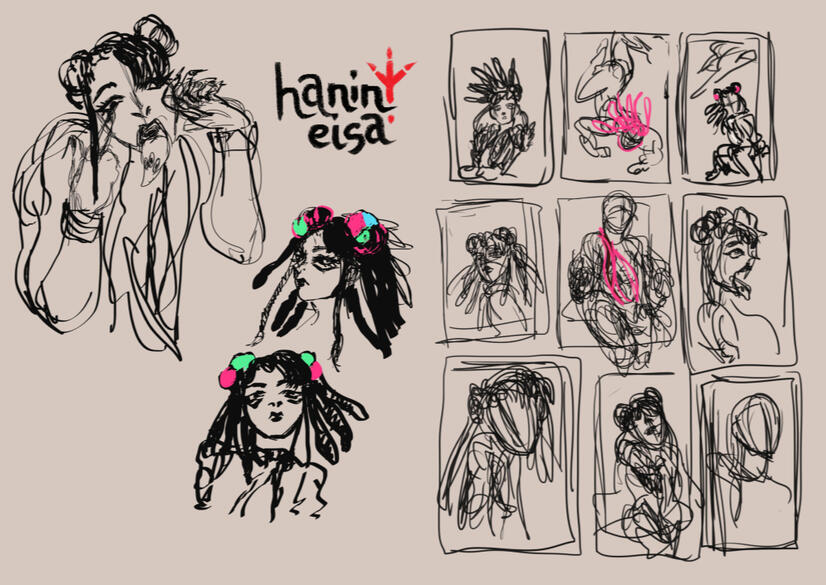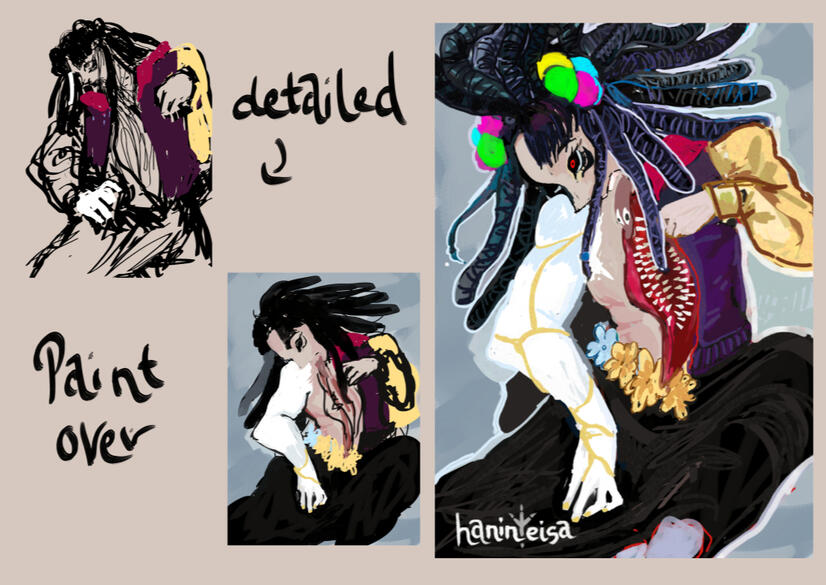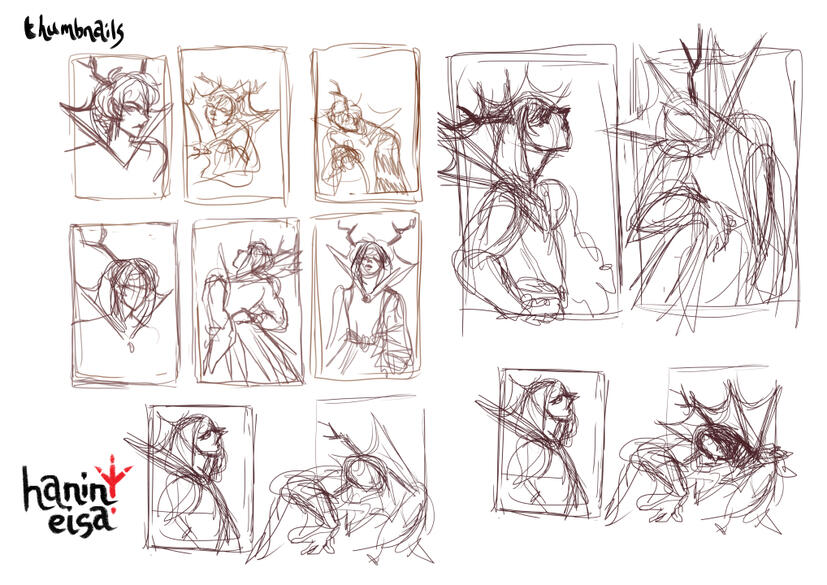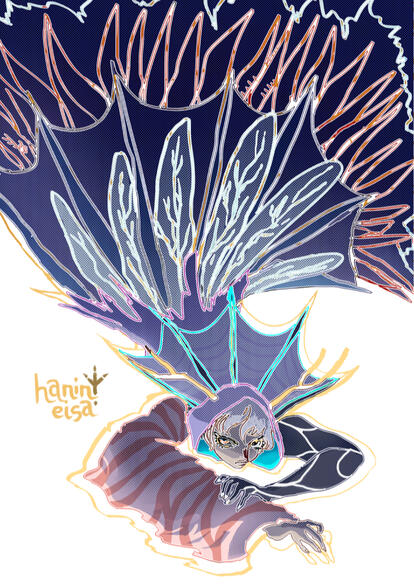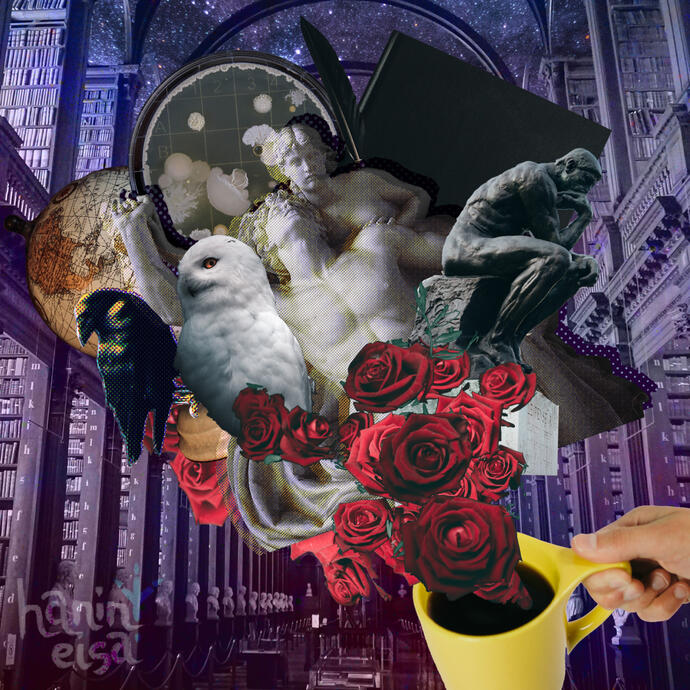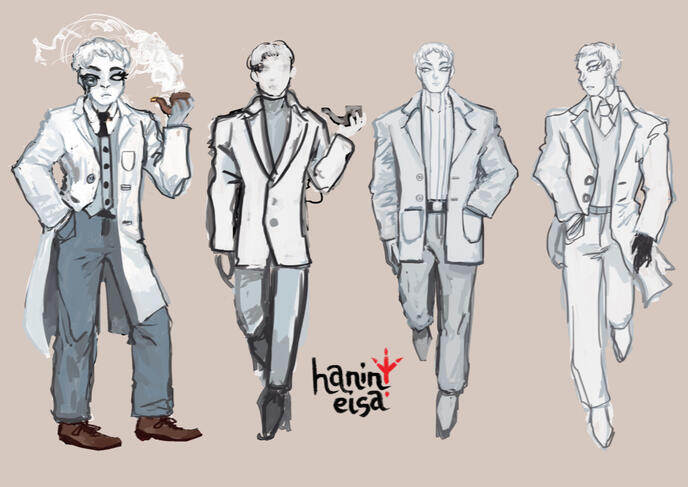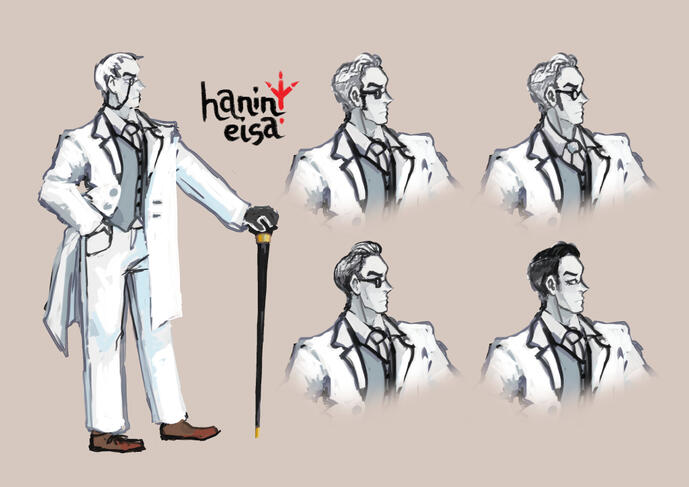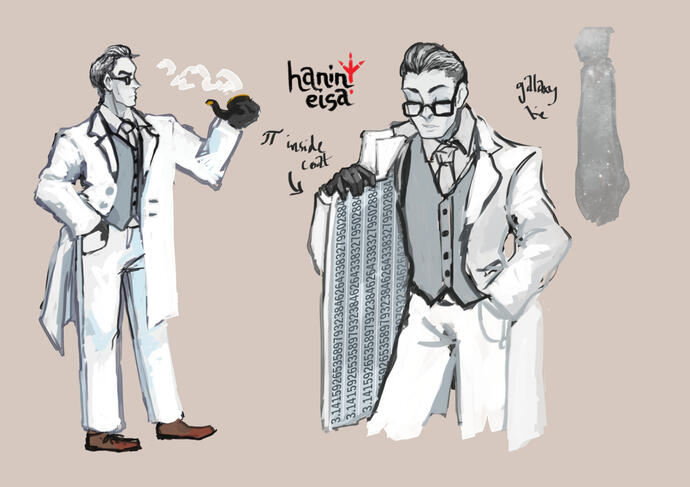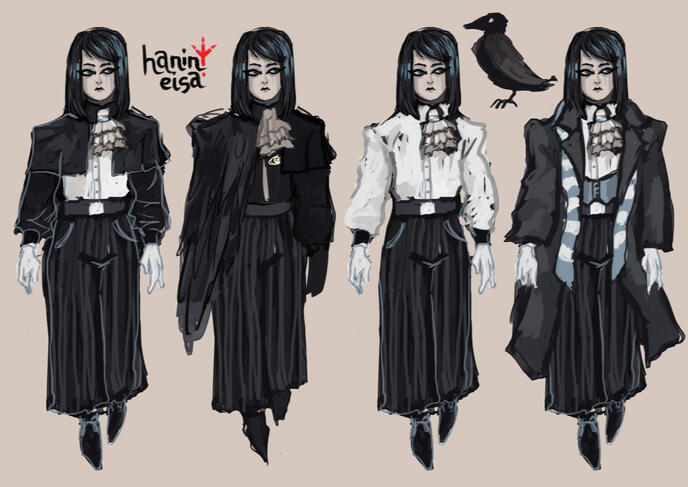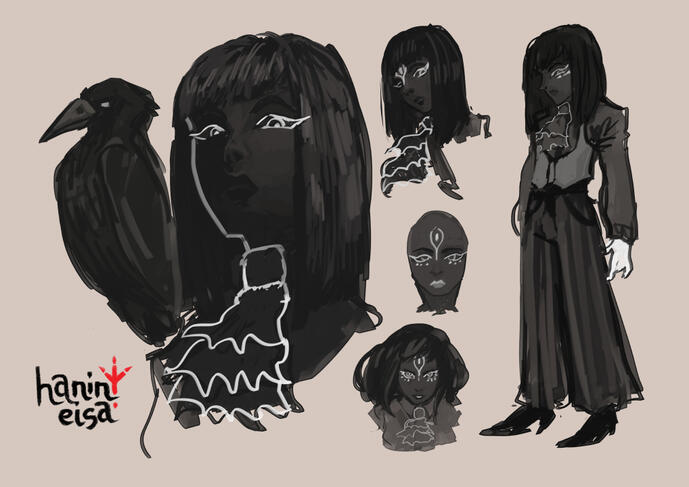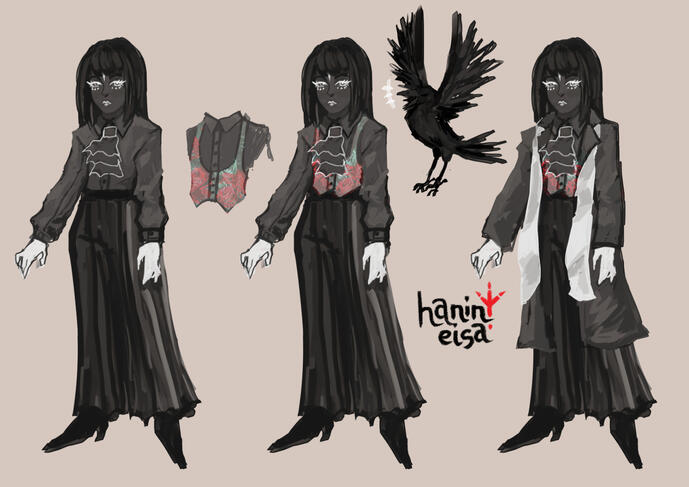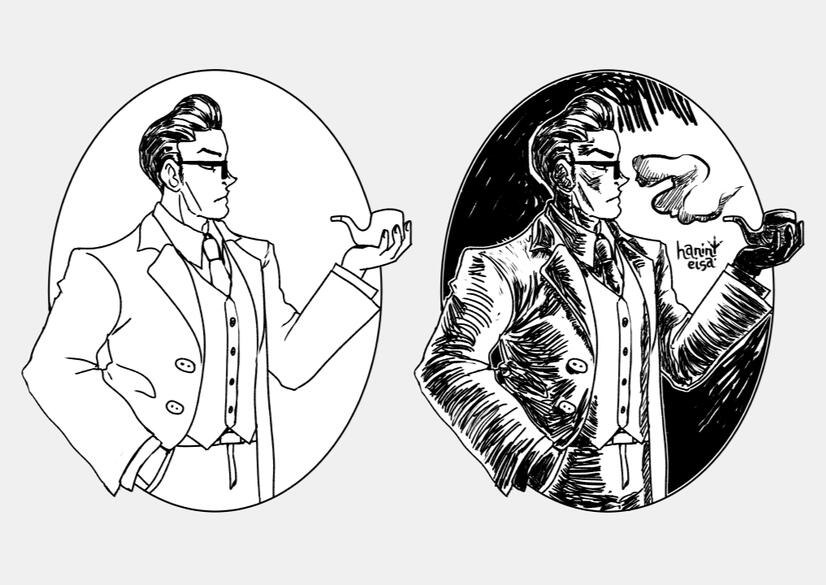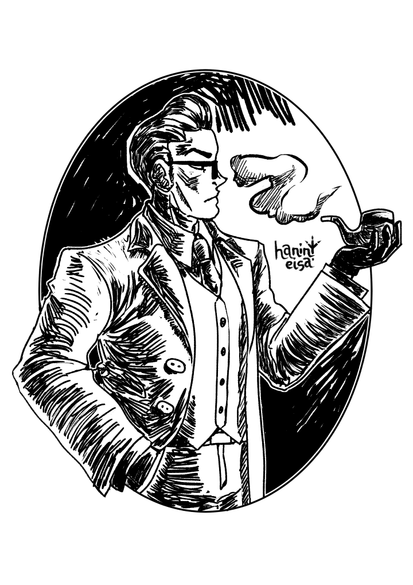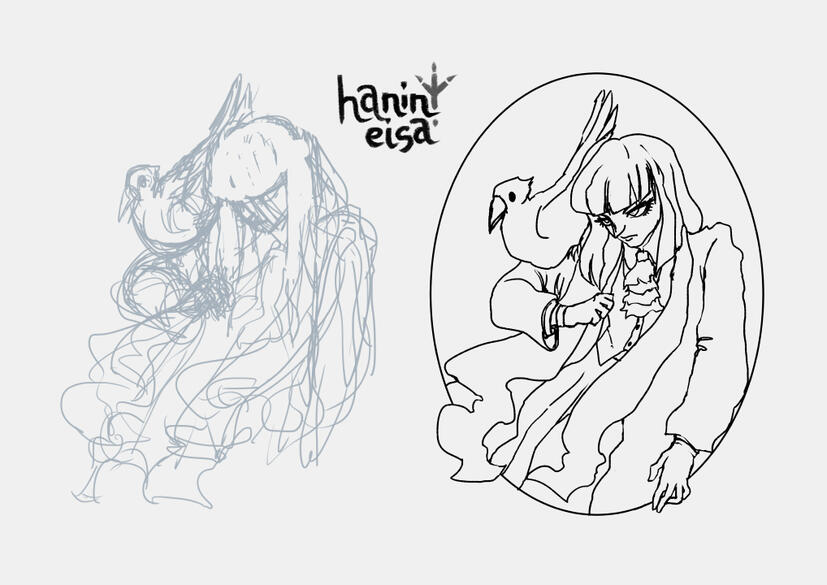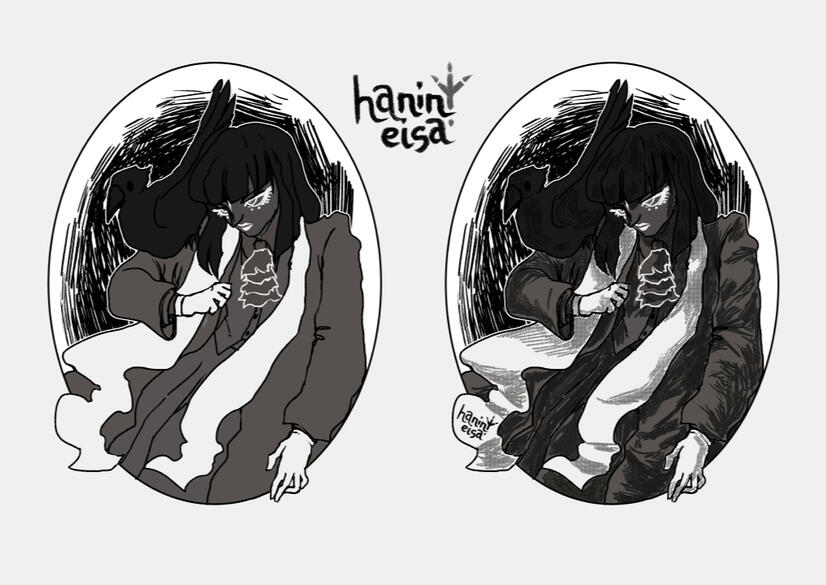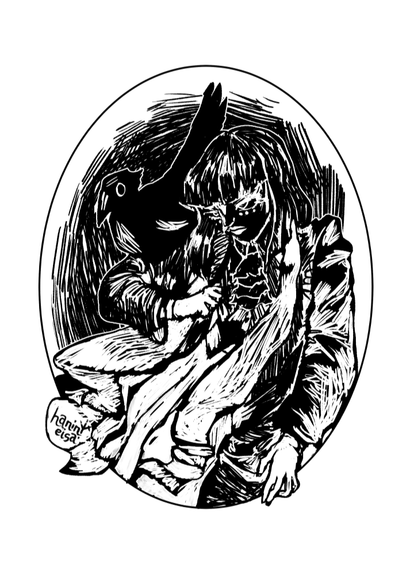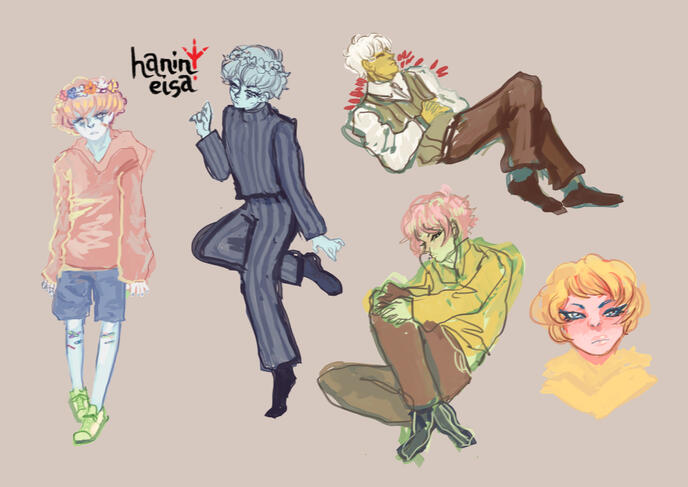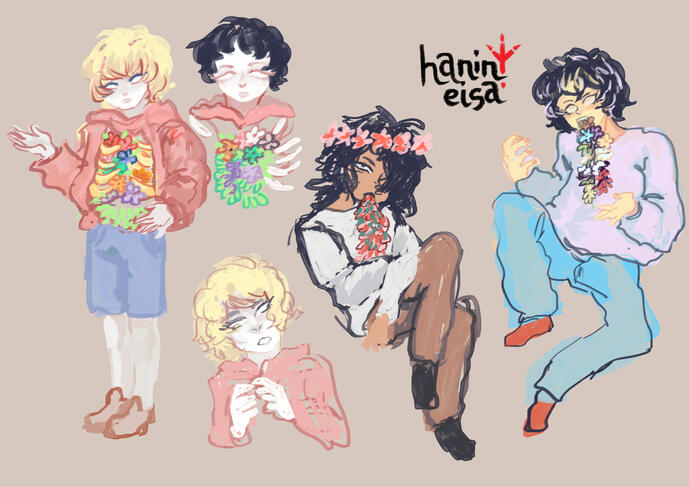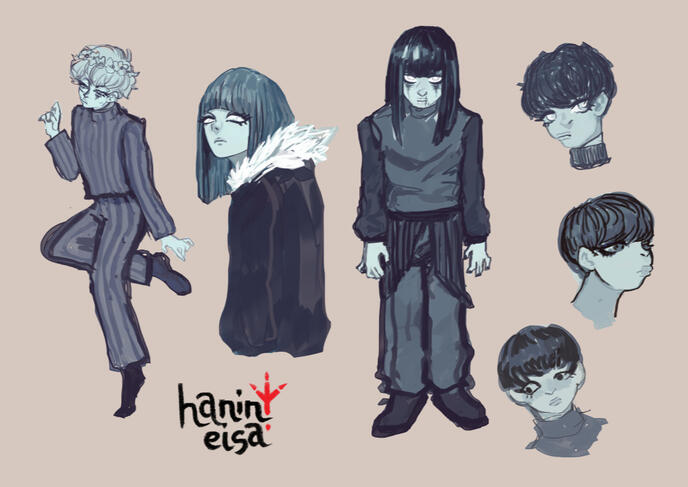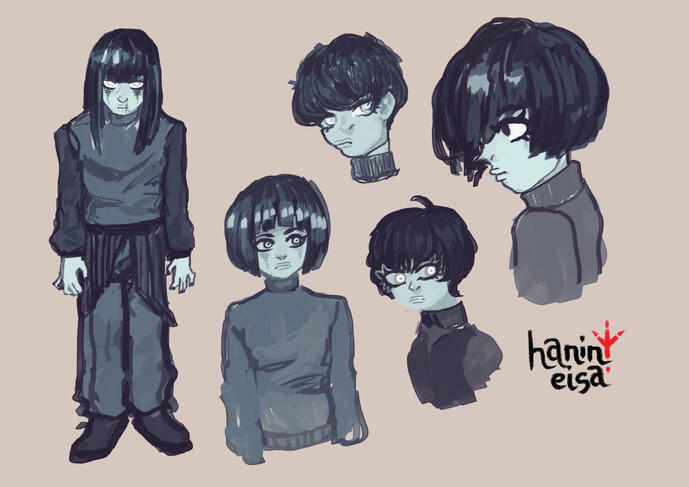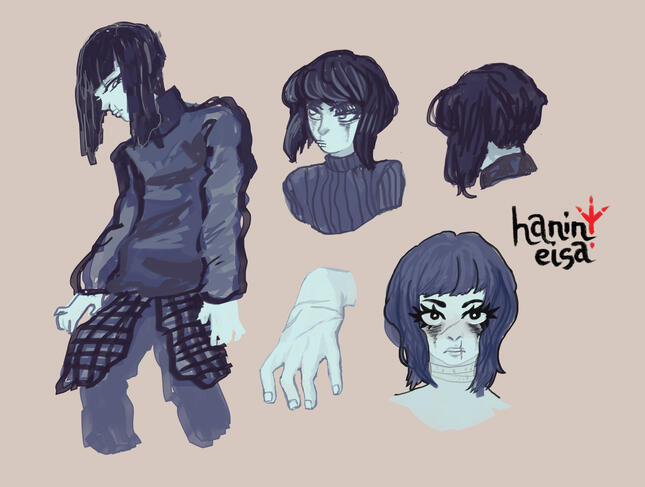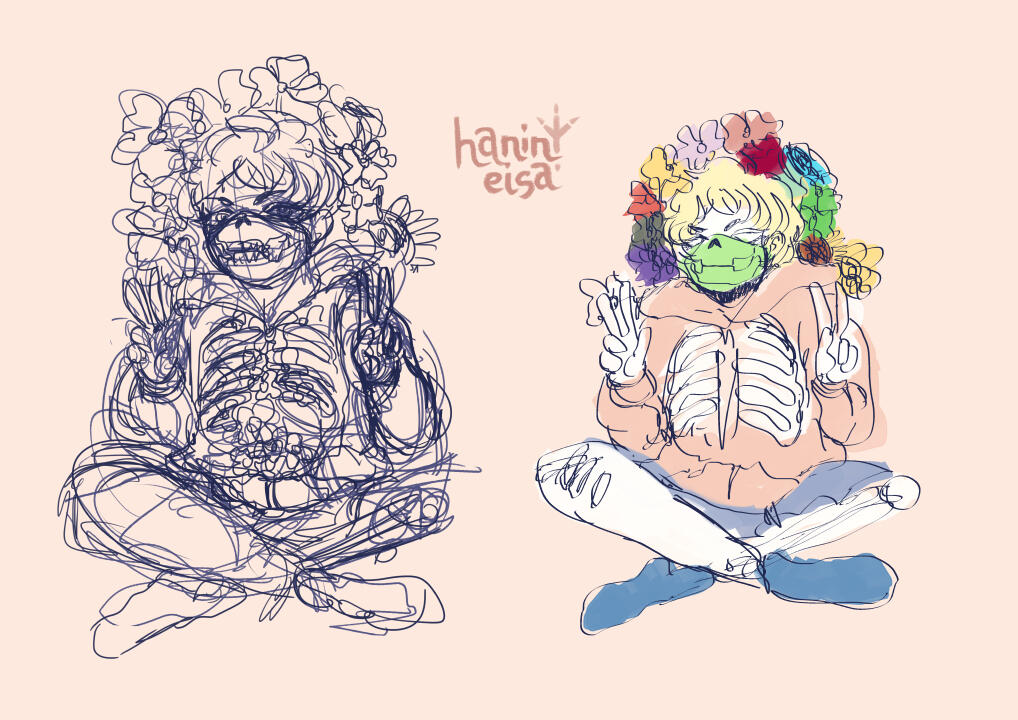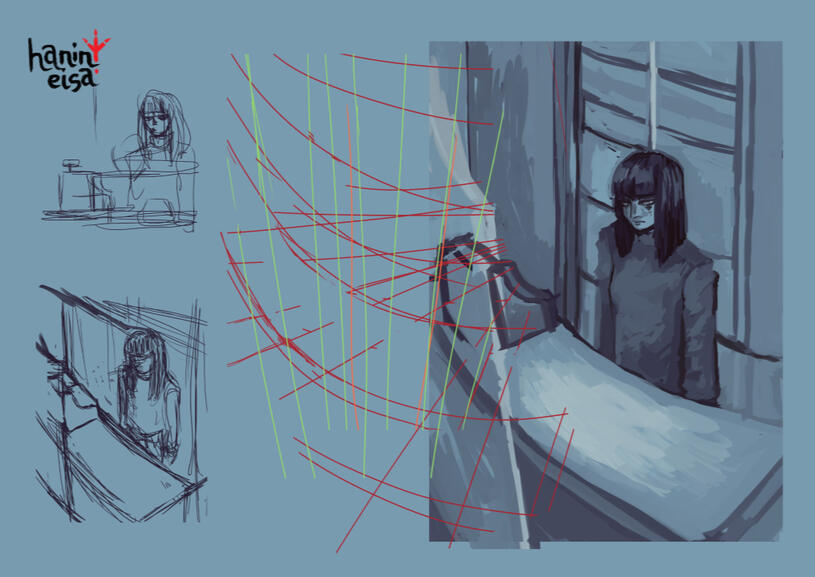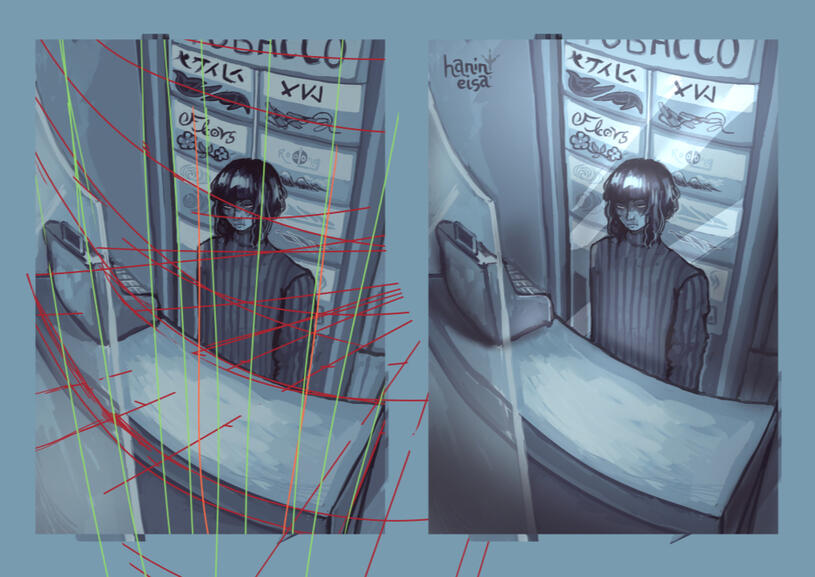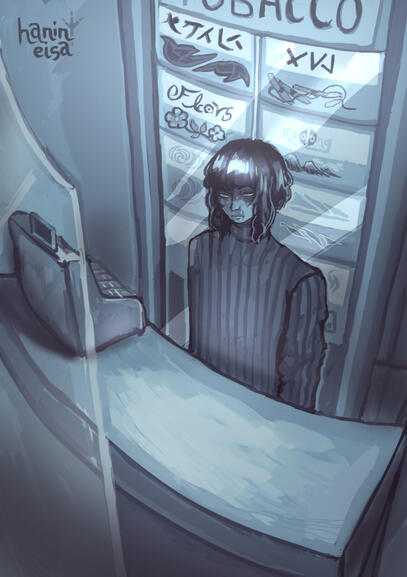The Aesthetic of Things
A series of Character Designs depicting the Aesthetics of Things
abstract
The word "Aesthetic" has expanded its meaning to the presentation of oneself, from fashion and colours, to food and behaviour. While this is similar to how fashion styles are developed, Aesthetic does not stop at the visual; it has been used to describe entire social phenomena and behaviours of groups. If the social processes and movements can be observed, then these aesthetics can be used to create art. Similarly, this gathering of qualitative data is also a method of research used in the creation of commercial art such as concept art and character designs, something that I am especially interested in.
"The Aesthetic of Things" is a series of Character Designs that aims to analyse three relevant themes that I observed in the late 2010s and its relation to science in the context of Aesthetics, and designs two characters representing their typical and alternative take in the respective aesthetic.
Introduction
Aesthetic, noun
Merriam-Webster: a branch of philosophy dealing with the nature of beauty, art, and taste and with the creation and appreciation of beauty.Lexico, powered by Oxford: A set of principles underlying the work of a particular artist or artistic movement. ‘the Cubist aesthetic’.A word to describe a look, heavily associated with the social blogging site Tumblr and its Vaporwave subculture.
Aesthetics tends to focus on artists and art movements but its study can be and has been expanded to entire behaviours, scenes, and moods. In Bence Nanay's Essay, "The Aesthetic Experience of Artwork and Everyday Scenes," he asserts that, "some of our aesthetic experiences are of artworks. Some others are of everyday scenes," and adds that "We should detach aesthetics from art, but do so carefully. Questions in aesthetics are often about art, but they don’t have to be." That being said, Nanay understands that experiencing Art aesthetically is necessary to experience scenes aesthetically, a point Ernst Gombrich has made. (Nanay, Bence, 2018)
The word "Aesthetic" in association with the music genre Vaporwave and its community on social blogging site Tumblr is more in line of the second definition presented but is instead used to describe a component in the expression of oneself. (eg. "I really enjoy your pastel aesthetic blog".) This is particularly true in the age of social media, where you can personalize your image. While the use of the word is sincere, Internet culture does also warp it ironically. Vaporwave, a genre featuring "heavy sampling and editing, surreal and futuristic themes, and 1980s and 1990s imagery, musical styles, and consumer culture" (Slang by Dictionary.com. n.d.), is self-aware nostalgia for an older, simpler, but idealized time. A comforting, old tone that is depressing in current year context. The defining track is MACINTOSH PLUS's second track, Lisa Frank 420 / Modern Computing in their 9th album, Floral Shoppe released in 2011.
Natalie "ContraPoints" Wynn's Video demonstrates an example of aesthetics in her video of "Opulence" (Wynn, Natalie, 2019) , defined as "the aesthetic of owning everything". She elaborates cutting between character monologues and commentary to present Opulence in philosophical, historical, and in cultural contexts, especially when in regard to "the American Dream". Wynn states that our aesthetics and tastes are based on social class and upbringing, very different compared to Nanay and Gombrich. For the wealthy, Opulence is showing off Wealth and Success to others whereas for the unwealthy, it is a simulation of wealth. If you wear a suit, then you feel accomplished and when they do become accomplished, they still simulate an accomplished person. The people who simulate tend to also be the marginalized, specifically lower-income People of Colour and the LGBTQ+, whose terms travel and become common use. This behaviour is also seen when YouTubers' content becomes more about spending money and gradually lose touch with their initial "relatable" brand. YouTube as a career is recent but this behaviour seen across generations, especially in western-influenced cultures. "Opulence" is a signifier of ever-changing era-specific success.
So, if an Aesthetic is a presentation of the culmination of art and art movements, music, literature, moods, behaviours, and other things observed, then an aesthetic is something quantifiable. Consolidating qualitative data is what you see in science when creating case studies but this is a step in creating commercial art. Character Design draws inspirations from media and real life and aims to tell a story with a character's look through their culture, mannerisms, and visual language.
With this, is it possible to mould entire social phenomena into an aesthetic and to utilize it as a basis for a character design? This website explores three aesthetics related to science and employs character design principals in its typical and alternative view. It will show the concept art and its journey to the final piece with annotations.
The Aesthetic of Beauty
While the saying "Beauty is in the Eye of the Beholder" is true, the definition of Beauty in regard to Humans is through social, biological, and environmental constraints. For example, we equate Beauty to good Health. However, when introducing Socio-economic factors and the environment of the perceiver, we find that "our representation of what constitutes an attractive and healthy body appear to be flexible. When conditions within an environment change, or when someone moves between environments, their health preferences appear to reflect this change in the local optima for survival." (Martin J. Tovée et al., 2007) It is no secret that attractive people have many advantages such as better pay, sooner promotions, and smaller punishments (Idealog. 2015) , and that we tend to equate beauty with goodness due to the likely link that "both (beauty and good) are important signals of survival efficiency". (Démuth, Andrej. 2017).
Furthermore, the connection between Nature and Beauty is also rooted in society and biology: a nature drawing is a classical view of beauty and the context in which said drawing is presented also determines its "beauty" (e.g. The Mona Lisa is hung in the Louvre, therefore the Mona Lisa is beautiful). Museums tend to follow a sophisticated stance as well, in that Art is appreciated in a specific way, though this can lead to Mischaracterization and Misinformation, intentionally and unintentionally. An example is the statue of Augustus Caesar, which has been proven to be painted as opposed to white. (Joseolgon. 2017) It only appeared white due to colour degradation when it was first discovered and that, and many other pieces, defined classical art. It wasn't painted until it was proven through modern technology, and even so it wasn't considered appealing. You may find information of the statues being coloured but it is rarely taught outside of art history.
The feminine and masculine ideal has both social and biological components. In many animal species, ornamentation and dress plays a large role in finding a partner for both male (Enbody, Erik D., et al. Apr. 2017) and female (Bhattacharjee, Yudhijit. 2002). The Uncanny Valley (Hsu, Jeremy. 2012) and having an aversion towards certain colour combinations and patterns subverts these components. Beauty can be also expressed through mathematical patterns (G.B.Johnsona, Steinerberger. 2019) which their traits are "universality, objectivity, truthfulness, aesthetics, resistance and applicability"(Nascimento, Marcio. 2018). The golden ratio and the Fibonacci Sequence, the Pythagorean theorem, and symmetry (Coffin A., Tom. n.d.) fit these criteria. That being said, there are aspects of Nature that we associate as being signifiers for beauty, such as flowers, some animals such as peacocks and butterflies, and precious gemstones.
Objects also are subject to beauty standards and it is known that beauty is defined differently between others. Some argue that if an object becomes broken, it's not pretty anymore ("damaged goods") but other arguments such as Kintsugi or the "gold joinery", a Japanese technique where broken pottery are joined together with lacquer in powdered gold, (Carnazzi, Stefano. 2016) challenge this; the gold cracks mark an important moment in the object's history and while it may not be useful anymore, in return is a one-of-a-kind ornament more beautiful than before. This "broken" imagery is also applied to humans, especially in relation to Physical and Mental Health. Where the arguments diverge is that one is about being flawless and the other is about being repaired beautifully after being broken.
"Philosophers, scientists and writers have tried to define the essence of beauty for thousands of years. The plurality of their efforts illustrates the immense difficulty of this task" and "as a species, we are so thoroughly saturated with symbolism, ritual and art — so swayed by rapidly changing fashions — that it is more or less impossible to determine just how much an aesthetic preference owes to evolutionary history as opposed to cultural influence." (Jabr, Ferris, 2019) Yet we insist and push specific images of "Beauty" despite its fickleness, and the scientific explanations and the history of what is and was beautiful are constantly being debated and researched to this day. The fact that we can quantify and manufacture these ideas of Beauty especially in relation to other cultures, class, and social upbringing shows that it is an Aesthetic.
Concept Art
For the classical, typical view of beauty, I designed Valley. With ethereal natural elements and a bigger-than-life personality, their initially bold colours which show a fish fin, insect wings, feathers, and fur, were turned paler to resemble the faded colours of marble statues. It also speaks to the Rococo Art where drama, myth, and pastel colours were used often. The antlers and cyan highlighted fin Medici collar creates a halo and their clothes mix high-fashion and fantasy, where you find classical views of beauty in both. Additionally, their straight and androgynous physique emphasizes the hourglass shape the clothes create. The Kintsugi Arm stands out but works together with their clothes and with a pose reminiscent of the Virgin Mary and Vogue, Valley steps with presence and elegance. In contrast with Canny, the alternative take, they play diva and nothing more.
Concept Art of Canny, Hanin. Digitial
Canny is an alternate more human-based take of the beauty aesthetic. Their urban design exaggerates human features, such as skin colour, hair, and body. I picked vibrant fashion and mixed different Harajuku Street and Punk styles while Canny mixes skin tones to resemble vitiligo and hairstyles (dreadlocks, braids, loose hair, updos, and hair dying) to show the variety of cultures.
That being said, while Canny looks human, they are not quite there yet. Their “Uncanny” form shows an all-consuming mouth and eyeballs in the tongue. Their expression ranges from normal and human to exaggerated and creepy and focuses on body horror. This all helps create a cohesive look where Canny is an extreme fascination of the human body.
Concept Art of Valley, Hanin. Digitial
Illustrations
What connects both Canny and Valley are their eyes and their Kintsugi arm which loosely follow the pattern of muscle shapes. They both relate beauty with nature but diverge in the parts of nature they emphasize. Valley focuses beauty found in nature while Canny searches for beauty in humans, regardless of their nature. Valley is elegant, extravagant, and traditional while Canny is wild, loud, and modern. I posed the characters accordingly, with Canny doing a manic dance and Valley posing for the camera like a photoshoot.
Illustrations of Canny and Valley, Hanin. Digitial
In short...
Beauty is affected by socio-economic status and biology, and holds images that are different between people in society. What came first is still debated.
The Aesthetic of Intellectuals
Intelligence and Science is a recurring theme that tend to be paired together. Wisecrack's 2019 Video about the Film "Idiocracy" points out that the US is experiencing a wave of pseudo-intellectualism as opposed to the film's criticism of "Anti-Intellectualism". Using people who believe in conspiracy theories as an example, Wisecrack explains that they participate in Intellectualism by following the scientific method, but their conclusions are vastly different due to their lack of in-depth understanding of their topic, as opposed to the outright rejection of science, the arts, and language.
The Rick & Morty Copypasta is an example of this behaviour as well though in albeit sarcastic response. It is a copy-pasted block of text in response to the people who criticize the animated show, Rick & Morty, essentially saying that the show is intelligent and they are not intelligent enough to understand its subtle nuances. (Know Your Meme, 2017) While the text is highly likely a joke, this does happen in earnest and does not stop at media critique and conspiracy theories; communicating in a logical tone is persuasive and is often used to justify reprehensible rhetoric, such as in World War 1 and World War 2, (Comas, Juan. 1961) and severely problematic behaviour especially in regard to race (E. Ruane, Michael. 2019) The language we use within science and research does lead to confusion. For example, how "race" is defined in genetics is different between scientists. (Hunt and Megyesi, 2008).
On another side, there are groups of people who simply embrace the atmosphere of a sophisticated and learned person through their fashion, their moods, their literature, media consumed, their art, etc. Their academia aesthetic revolving around mostly literature, friendship, coming of age, love, and themes of death, and class difference, to name a few (therese, m.. 2019) is viewed romantically. In comparison to the logical, this aesthetic is more emotionally-charged. That being said, it does also suffer the same problem in regard to the intent of its communication. After all, being learned earns you respect and there is an added aspect of snobbery to it.
What is also to notice is that all of them focus specifically on western-influenced philosophy and art. While the participants of the intellectual aesthetic do also incorporate philosophy and art from other schools of thought, it is used to enhance the overall western outlook. The west being perceived as top class is undeniable, especially when you consider their history with other groups of people. All participate in the image of a learned person as being learned can earn you respect. Their intentions and the takes of an intellectual are vastly different between them but the Copypasta, the pseudo-intellectuals, and the artistic viewer demonstrate the need to uphold an image where Science as a backdrop.
Concept Art
I designed Pi to embody the traditional intellectual mindset and type, as portrayed in media and in people’s heads. They are of later age and wear traditionally dapper suits to accompany their aura. The reference to mathematics, with the number Pi inside their coat, and space-themed tie exemplify it as well. A part of the Intellectual Aesthetic is the pondering of “the Meaning/Purpose of Life” through a cold and calculating lens. They also present themselves as more masculine as that is the typical demographic of people who practice this aesthetic.
Concept Art of Pi, Hanin. Digitial
In contrast to Pi, Ash is a romantic perception of knowledge. They are dark, mysterious, and more importantly androgynous, as the majority of people that consume Ash’s aesthetic are from very diverse range of identities. They lean into a more fantasy aesthetic with the facial markings and the Harry Potter-inspired fashion. This fashion staple then branched out to just general “posh” autumn wear. The raven is an important pet and is often quoted in fiction and fantasy, especially in reference to writers such as Edgar Allan Poe. Additionally, the red rose flower also sells this aesthetic further, as they themselves are considered romantic.
Concept Art of Ash, Hanin. Digitial
Illustrations
They both represent knowledge but have different takes on how they perceive and consume knowledge. I decided to frame both of these characters in an oval shape. Originally, I wanted Pi to mimic the photograph of Sigmund Freud but have found that mimicing the old sketches and etchings to be far more effective. For Ash, I inverted the light. The Light and Dark contrast creates an interesting pair of pictures.
Illustrations of Pi and Ash, Hanin. Digitial
In short...
Looking smart and being smart are two strongly related concepts that can be mutually exclusive.
The Aesthetic of Illness
These depictions of Illness, whether it be in diagrams and textbooks or in Art and Media, have an informative component and a social component. These two depictions are not mutually exclusive in their use. While you can draw scientific depictions to inform, the social uses are imperative for providing connection and awareness, an especially important aspect as a scientist nowadays. Successful Science Communication is key for research funding and to inform (Leitat. 2019), Dr. Jennifer Fong Ha and Nancy Longnecker from the Ochsner Journal, state that Doctor-Patient Communication is key to a successful treatment (Ha, Jennifer Fong, and Longnecker, Nancy. 2010), and Thomas J. Powell and Brian E Perron assert that creating Patient Support Groups is key to cultivating a community. (Powell, Thomas J., and Brian E. Perron., edited by Louis D. Brown and Scott Wituk, Springer. 2010)
Not only that, proper representation demographics is also essential for better healthcare (Hasnain-Wynia and Baker. 2006). There is already a subtle bias against hiring women in STEM, even when they were just as competent as the men (Moss-Racusin et al. 2012). Diverse patients are also underrepresented in critical conditions, such as autism in minorities (University of Kansas. 2018) and HIV in females (Feldman et. al. 2019). There are studies showing dangerous representation of unhealthy habits and mental illness in media contribute greatly to its stigma. The public engages with these topics through Media. (Srivastava, et al. 2018)
The participation of certain Aesthetics come with consequences. Either with using black and white with melancholic images or invoking pastel colours and floral imagery, the idea that being broken is okay, beautiful even is present and romaticized. While these styles can be used to cope and communicate illness, social media and the media perpetuate the Myth of the Tortured Artist (The Art Assignment. 2018). Art's relationship with Creativity and Mental Illness is also studied and a meta-analysis on Schizophrenia and creativity by Selcuk Acar, Xiao Chen, and Nur Cayirdag in 2018 has shown that "a mild expression of schizophrenia symptoms may support creativity but a full demonstration of the symptoms undermines it."(Acar et al. 2017) In fact, "Mental illness is neither necessary nor sufficient for creativity." (Kaufman, Scott B., 2013)
A death or illness that is "pretty", also plays into the aesthetics of illness. An interesting case of this is the yami-kawaii or "sick cute" (Chitrakorn, Kati. 2018) genre that has surfaced in Japan. While the fashion style is used among people to show they struggle, especially in a society that deems the subject as taboo, there are those who simply enjoy the aesthetic. That being said, some do also enjoy accounts of illness, whether they were terminal or overcome. "In that sense, to join with another in the witnessing of his or her own suffering from disease is also to engage in an aesthetic act, in which the countenancing of the sublime is achieved in the light of horror and of pleasure." (Radley, Alan. 1999) Art itself has its use in not only medicine but also in Art Therapy and in Science Communication. While both yami-kawaii and accounts of illness come from different angles, the social role is identical; the creator expresses, while the audience learns about a highly intimate reality.
When it comes to Illness, it is far easier to represent a broken bone than a mental affliction simply by the nature of how illness manifests.
Concept Art
I had Flor use mostly soft colours with also earthy and foresty greens and yellows in there. The use of flowers and botany in the healing process is frequently practised by placing plants and gardens in hospital rooms. There are several studies documenting on how simply looking at nature and plants reduces stress. (Ulrich, S. Roger, 2002) That being said, flowers are also a beauty signifier, meaning a possibility in the association of beauty and illness.
Additionally, other signifiers of illness are also in the human body, specifically skeletons and mending techniques (bandages, plaster, etc). Having the ribcage, spine, and the skeleton left leg be visible and also bulging and holding all the flowers draws attention to them. I essentially took aspects of yami-kawaii to the extreme.
Concept Art of Flor, Hanin. Digitial
Madon in contrast takes a more reserved and muted artificial colours. Where Flor is about the outward illness, Madon is someone that is inwardly ill instead. There are studies that show the strong connection between mental health and the manifestation of its symptoms. Madon is instead more subtle and draws attention to their scars, the greasy hair, the heavy dark circles, their bandages, and their bitten nails. They look normal all things considered, but they are not taking care of themselves well, which is why they put effort into hiding this.
Concept Art of Madon, Hanin. Digitial
Illustrations
Both of these take the aesthetic associated with illness and healing while using different colours to portray how their illness manifests. Flor and Madon are character where simple but effective composition plays an important role in their design and I focused more on setting the mood here. For Flor, they are cross-legged in front of flowers with the peace signs in very vibrant colours while Madon is standing under harsh light at a gas station/tobacco store with a palette consisting only of blues, and rich black.
Illustrations of Flor and Madon, Hanin. Digitial
In short...
How illness looks like plays a role in how we treat it.
